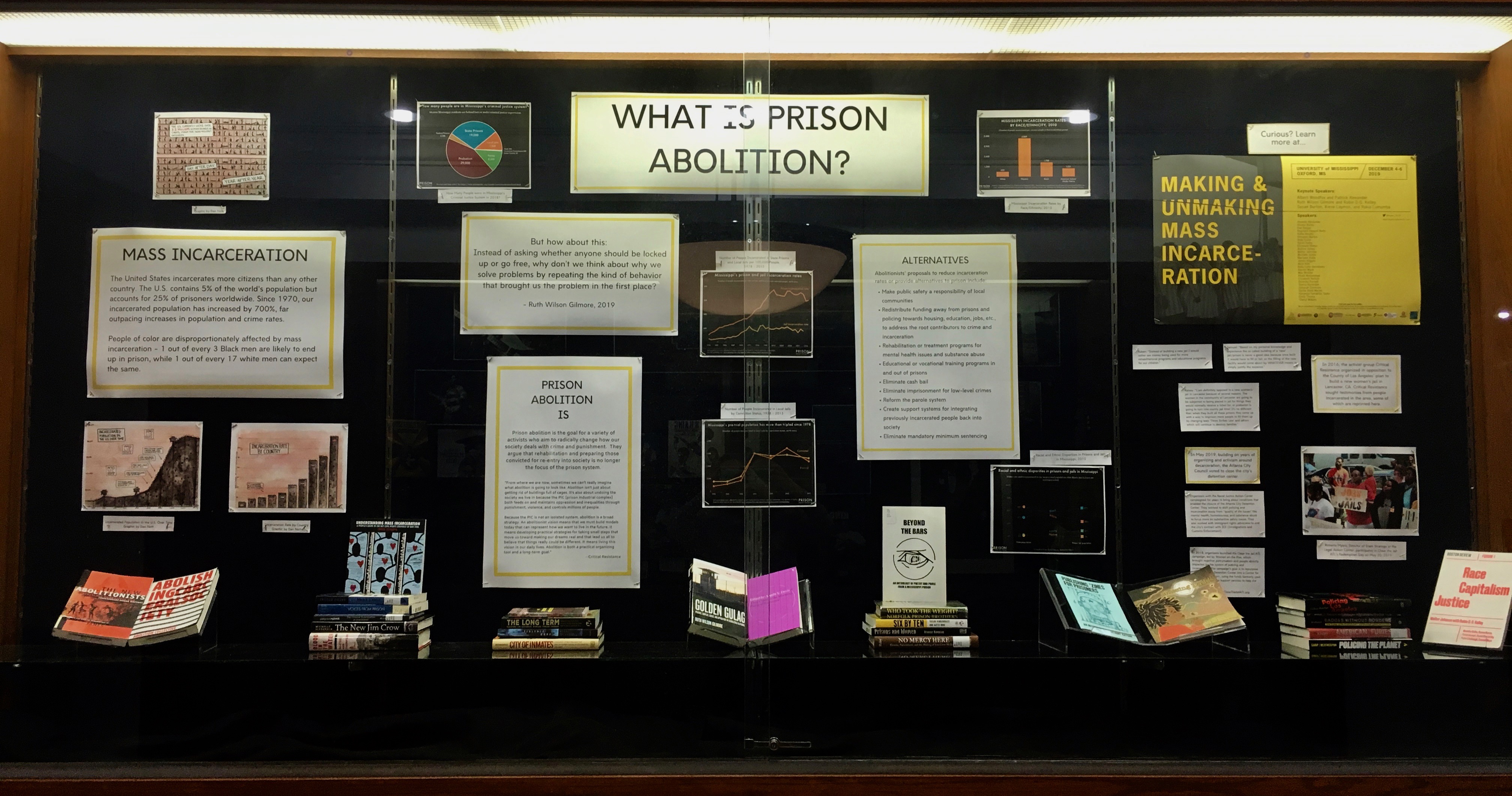
J.D. Williams Prison Abolition Exhibit
Mass Incarceration
The United States incarcerates more citizens than any other country. The U.S. contains 5% of the world’s population but accounts for 25% of prisoners worldwide. Since 1970, our incarcerated population has increased by 700%, far outpacing increases in population and crime rates.
People of color are disproportionately affected by mass incarceration – 1 out of every 3 Black men are likely to end up in prison, while 1 out of every 17 white men can expect the same.
Prison Abolition
“But how about this? Instead of asking whether anyone should be locked up or go free, why don’t we think about why we solve problems by repeating the kind of behavior that brought us the problem in the first place?” – Ruth Wilson Gilmore, 2019
Prison Abolition Is…
Prison abolition is the goal for a variety of activists who aim to radically change how our society deals with crime and punishment. They argue that rehabilitation and preparing those convicted for re-entry into society is no longer the focus of the prison system.
“From where we are now, sometimes we can’t really imagine what abolition is going to look like. Abolition isn’t just about getting rid of buildings full of cages. It’s also about undoing the society we live in because the PIC [prison industrial complex] both feeds on and maintains oppression and inequalities through punishment, violence, and controls millions of people.
Because the PIC is not an isolated system, abolition is a broad strategy. An abolitionist vision means that we must build models for today that can represent how we want to live in the future. It means developing practical strategies for taking small steps that move us toward making our dreams real and that lead us all to believe that things really could be different. It means living this vision in our daily lives. Abolition is both a practical organizing tool and a long-term goal.”
–Critical Resistance
Alternatives
Abolitionists’ proposals to reduce incarceration rates or provide alternatives to prisons include:
• Make public safety a responsibility of local communities
• Redistribute funding away from prisons and policing towards housing, education, jobs, etc., to address the root contributors to crime and incarceration
• Rehabilitation or treatment programs for mental health issues and substance abuse
• Educational or vocational training programs in and out of prisons
• Eliminate cash bail
• Eliminate imprisonment for low-level crimes
• Reform the parole system
• Create support systems for integrating previously incarcerated people back into society
• Eliminate mandatory minimum sentencing
No New Jail – Lancaster, CA
In 2016, the activist group Critical Resistance organized in opposition to the County of Los Angeles’ plan to build a new women’s jail in Lancaster, CA. Critical Resistance sought testimonies from people incarcerated in the area, some of which are reprinted here.
Samuel: Based on my personal knowledge and experience the so called building of a “new” jail/prison is never a good idea because once built it would have to fill or fail, so the filling of the new facility would come about by WHATEVER means to simply justify the expense.
Kelsey: I am definitely opposed to a new women’s jail in Lancaster because of several reasons. The women in the community of Lancaster are going to be subjected to being placed in jail for things they would normally receive a ticket for, or probation is going to turn into county jail time! It’s no different than when they built all these prisons they came up with a way to imprison more people to fill them up by changing laws “Three Strikes Law” and others which will continue to destroy families.
Ruben: Instead of building a new jail I would rather see money being used for more rehabilitational programs and educational programs for our children.
Close the Jail – Atlanta, GA
In May 2019, building on years of organizing and activism around decarceration, the Atlanta City Council voted to close the city’s detention center.
Organizers with the Racial Justice Action Center campaigned for years to bring about conditions that enabled the closure of the Atlanta City Detention Center. They worked to shift policing and incarceration away from “quality of life issues” like mental health, homelessness, and substance abuse to focus more on substantive safety issues. They also worked with immigrant rights advocates to end the city’s contract with ICE (Immigrations and Customs Enforcement).
In 2018, organizers launched the Close the Jail ATL campaign, led by Women on the Rise, which brought together policymakers and people directly impacted by the system of policing and incarceration. The campaign’s goal is to repurpose the Atlanta City Detention Center into a Center for Wellness and Freedom, using the funds formerly used to support the jail to support services to help the community thrive.
Sources Consulted
Critical Resistance
http://criticalresistance.org/
Prison Policy Initiative
https://www.prisonpolicy.org/
The Brennan Center for Justice
https://www.brennancenter.org
The Council of State Governments Justice Center
https://csgjusticecenter.org/nrrc
“Is Prison Necessary? Ruth Wilson Gilmore Might Change Your Mind.” New York Times Magazine feature by Rachel Kushner
https://www.nytimes.com/2019/04/17/magazine/prison-abolition-ruth-wilson-gilmore.html
“What Do Abolitionists Really Want?” The Marshall Project, by Bill Keller
https://www.themarshallproject.org/2019/06/13/what-do-abolitionists-really-want
“What is Mass Incarceration?” by Daniel Nott
https://medium.com/@dan_nott/what-is-mass-incarceration-ff737196580
Close the Jail ATL
https://www.closethejailatl.org/
Exhibit Contributors:
Cecelia Parks
Rachael McDuffey
Garrett Felber
Brody Watson
Sara Wilson
Natalie Teyema
